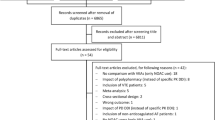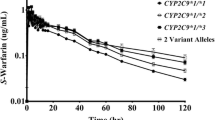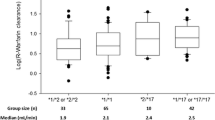Abstract
Aims
Warfarin is a frequently used anticoagulant drug with narrow therapeutic index and high interindividual variability in the dose requirement. We have previously shown that warfarin dose is influenced by cytochrome P450 (CYP) 2C9 genotype, age, body weight and co-treatment with drugs that interfere with warfarin metabolism. As, in many patients, drug co-treatment cannot be avoided, we investigated the effect of co-treatment with carbamazepine, amiodarone and statins on warfarin metabolism and maintenance dose.
Methods
Caucasian patients on stable maintenance warfarin therapy with CYP2C9*1/*1 genotype (n=82) were included in the study. Plasma concentrations of (S)- and (R)-warfarin as well as warfarin hydroxylated metabolites were determined using HPLC assay and corresponding clearances of (S)- and (R)-warfarin were calculated.
Results
Patients co-treated with carbamazepine (n=5) had significantly higher plasma 10-hydroxywarfarin concentrations than patients not taking any interacting drugs (n=54) (median: 0.327 μg/ml vs 0.030 μg/ml, p=0.003). (S)- and (R)-warfarin clearances were also higher in the carbamazepine co-treated group (p=0.003), as were warfarin dose requirements (median: 9.00 mg/day vs 3.86 mg/day, p=0.003). Under the conditions of this study, patients co-treated with amiodarone (n=6) did not differ significantly regarding any measured characteristic from patients with no interacting drug treatment, while patients co-treated with simvastatin or lovastatin (n=17) had lower 10-hydroxywarfarin concentration (p=0.02).
Conclusions
We confirmed important interaction between carbamazepine and warfarin metabolism which can be of major clinical importance. If treatment with carbamazepine cannot be avoided, patients taking warfarin should be frequently monitored, especially when initiating or stopping carbamazepine therapy.


Similar content being viewed by others
References
Ansell J, Hirsh J, Poller L, Bussey H, Jacobson A, Hylek E (2004) The pharmacology and management of the vitamin K antagonists: the Seventh ACCP Conference on Antithrombotic and Thrombolytic Therapy. Chest 126:204S–233S
Gage BF, Fihn SD, White RH (2000) Management and dosing of warfarin therapy. Am J Med 109:481–488
Kaminsky LS, Zhang ZY (1997) Human P450 metabolism of warfarin. Pharmacol Ther 73:67–74
Herman D, Locatelli I, Grabnar I, Peternel P, Stegnar M, Mrhar A, Breskvar K, Dolzan V (2005) Influence of CYP2C9 polymorphisms, demographic factors and concomitant drug therapy on warfarin metabolism and maintenance dose. Pharmacogenomics J 5:193–202
Hillman MA, Wilke RA, Caldwell MD, Berg RL, Glurich I, Burmester JK (2004) Relative impact of covariates in prescribing warfarin according to CYP2C9 genotype. Pharmacogenetics 14:539–547
Hansen JM, Siersboek-Nielsen K, Skovsted L (1971) Carbamazepine-induced acceleration of diphenylhydantoin and warfarin metabolism in man. Clin Pharmacol Ther 12:539–543
Ross JR, Beeley L (1980) Interaction between carbamazepine and warfarin. Br Med J 208:1415–1416
Kendall AG, Boivin M (1981) Warfarin-carbamazepine interaction. Ann Intern Med 94:280
Massey EW (1983) Effect of carbamazepine on Coumadin metabolism. Ann Neurol 13:691–692
Denbow CE, Fraser HS (1990) Clinically significant hemorrhage due to warfarin-carbamazepine interaction. South Med J 83:981
Kerr BM, Thummel KE, Wurden CJ, Klein SM, Kroetz DL, Gonzalez FJ, Levy RH (1994) Human liver carbamazepine metabolism. Role of CYP3A4 and CYP2C8 in 10,11-epoxide formation. Biochem Pharmacol 47:1969–1979
Martinowitz U, Rabinovich J, Goldfarb D, Many A, Bank H (1981) Interaction between warfarin sodium and amiodarone. N Engl J Med 304:671–672
Rees A, Dalal JJ, Reid PG, Henderson AH, Lewis MJ (1981) Dangers of amiodarone and anticoagulant treatment. Br Med J (Clin Res Ed) 282:1756–1757
Hamer A, Peter T, Mandel WJ, Scheinman MM, Weiss D (1982) The potentiation of warfarin anticoagulation by amiodarone. Circulation 65:1025–1029
Kerin NZ, Blevins RD, Goldman L, Faitel K, Rubenfire M (1988) The incidence, magnitude, and time course of the amiodarone-warfarin interaction. Arch Intern Med 148:1779–1781
Almog S, Shafran N, Halkin H, Weiss P, Farfel Z, Martinowitz U, Bank H (1985) Mechanism of warfarin potentiation by amiodarone: dose - and concentration - dependent inhibition of warfarin elimination. Eur J Clin Pharmacol 28:257–261
Watt AH, Stephens MR, Buss DC, Routledge PA (1985) Amiodarone reduces plasma warfarin clearance in man. Br J Clin Pharmacol 20:707–709
O’Reilly RA, Trager WF, Rettie AE, Goulart DA (1987) Interaction of amiodarone with racemic warfarin and separated enantiomorphs in humans. Clin Pharmacol Ther 42:290–294
Cheung B, Lam FM, Kumana CR (1996) Insidiously evolving, occult drug interaction involving warfarin and amiodarone. BMJ 312:107–108
Sanoski CA, Bauman JL (2002) Clinical observations with the amiodarone/warfarin interaction: dosing relationships with long-term therapy. Chest 121:19–23
Heimark LD, Wienkers L, Kunze K, Gibaldi M, Eddy AC, Trager WF, O’Reilly RA, Goulart DA (1992) The mechanism of the interaction between amiodarone and warfarin in humans. Clin Pharmacol Ther 51:398–407
Andrus MR (2004) Oral anticoagulant drug interactions with statins: case report of fluvastatin and review of the literature. Pharmacotherapy 24:285–290
Gaw A, Wosornu D (1992) Simvastatin during warfarin therapy in hyperlipoproteinaemia. Lancet 340:979–980
Lin JC, Ito MK, Stolley SN, Morreale AP, Marcus DB (1999) The effect of converting from pravastatin to simvastatin on the pharmacodynamics of warfarin. J Clin Pharmacol 39:86–90
Hickmott H, Wynne H, Kamali F (2003) The effect of simvastatin co-medication on warfarin anticoagulation response and dose requirements. Thromb Haemost 89:949–950
http://www.theriaque.org/AnalyseOrdonnances/home.cfm (Date: 21st November 2005)
Yasar Ü, Eliasson E, Dahl ML, Johansson I, Ingelman-Sundberg M, Sjöqvist F (1999) Validation of methods for CYP2C9 genotyping: frequencies of mutant alleles in a Swedish population. Biochem Biophys Res Commun 254:628–631
Locatelli I, Kmetec V, Mrhar A, Grabnar I (2005) Determination of warfarin enantiomers and hydroxylated metabolites in human blood plasma by liquid chromatography with achiral and chiral separation. J Chromatogr B Analyt Technol Biomed Life Sci 818:191–198
Furuya H, Fernandez-Salguero P, Gregory W, Taber H, Steward A, Gonzales FJ, Idle JR (1995) Genetic polymorphism of CYP2C9 and its effect on warfarin maintenance dose requirement in patients undergoing anticoagulation therapy. Pharmacogenetics 5:389–392
Aithal GP, Say CP, Kesteven PJL, Daly AK (1999) Association of polymorphisms in cytochrome P450 CYP2C9 with warfarin dose requirement and risk of bleeding complications. Lancet 353:717–719
Ogg MS, Brennan P, Meade T, Humphries SE (1999) CYP2C9*3 allelic variant and bleeding complications. Lancet 354:1124
Taube J, Halsall D, Baglin T (2000). Influence of cytochrome P450 CYP2C9 polymorphisms on warfarin senstitivity and risk of over-anticoagulation in patients on long-term treatment. Blood 96:1816–1819
Margaglione M, Colaizzo D, D’Andrea G, Brancaccio V, Ciampa A, Grandone E, Di Minno G (2000) Genetic modulation of oral anticoagulation with warfarin. Thromb Haemost 84:775–778
Freeman BD, Zehnbauer BA, McGrath S, Borecki I, Buchman TG (2000) Cytochrome P450 polymorphisms are associated with reduced warfarin dose. Surgery 128:281–285
Tabrizi AR, Zehnbauer BA, Borecki IB, McGrath SD, Buchman TG, Freeman BD (2002) The frequency and effects of cytochrome P450 (CYP) 2C9 polymorphisms in patients receiving warfarin. J Am Coll Surg 194:267–273
Higashi M, Veenstra DL, Midori Kondo L, Wittkowsky AK, Srinouanprachanh SL, Farin FM, Rettie AE (2002) Association between CYP2C9 genetic variants and anticoagulation-related outcomes during warfarin therapy. JAMA 287:1690–1698
Scordo MG, Pengo V, Spina E, Dahl ML, Gusella M, Padrini R (2002) Influence of cytochrome P450 CYP2C9 and 2C19 genetic polymorphisms on warfarin maintenance dose and metabolic clearance. Clin Pharmacol Ther 72:702–710
Kamali F, Khan TI, King BP, Frearson R, Kesteven P, Wood P, Daly AK, Wynne H (2004) Contribution of age, body size, and CYP2C9 genotype to anticoagulant response to warfarin. Clin Pharmacol Ther 75:204–212
D’Andrea G, D’ambrosio RL, Di Perna P, Chetta M, Santacroce R, Brancaccio V, Grandone E, Margaglione M (2005) A polymorphism in VKORC1 gene is associated with an inter-individual variability in the dose-anticoagulant effect of warfarin. Blood 105:645–649
Yuan HY, Chen JJ, Lee MT, Wung JC, Chen YF, Charng MJ, Lu MJ, Hung CR, Wei CY, Chen CH, Wu JY, Chen YT (2005) A novel functional VKORC1 promoter polymorphism is associated with inter-individual and inter-ethnic differences in warfarin sensitivity. Hum Mol Genet 14:1745–1751
Rieder MJ, Reiner AP, Gage BF, Nickerson DA, Eby CS, McLeod HL, Blough DK, Thummel KE, Veenstra DL, Rettie AE (2005) Effect of VKORC1 haplotypes on transcriptional regulation and warfarin dose. N Engl J Med 352:2285–2293
Author information
Authors and Affiliations
Corresponding author
Additional information
This work was financially supported by the Ministry of Education, Science and Sport of Slovenia (Grants No. PO-0503-0381, P1-0170 and P1-0189-0787).
Rights and permissions
About this article
Cite this article
Herman, D., Locatelli, I., Grabnar, I. et al. The influence of co-treatment with carbamazepine, amiodarone and statins on warfarin metabolism and maintenance dose. Eur J Clin Pharmacol 62, 291–296 (2006). https://doi.org/10.1007/s00228-006-0104-4
Received:
Accepted:
Published:
Issue Date:
DOI: https://doi.org/10.1007/s00228-006-0104-4




